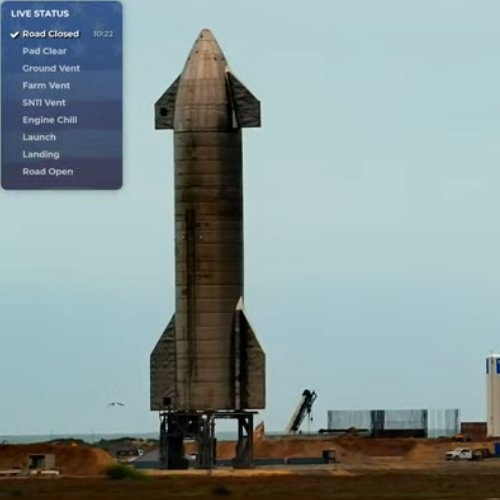Blue Origin completes another unmanned suborbital test flight of New Shepard
Capitalism in space: Blue Origin today successfully completed another unmanned suborbital test flight of New Shepard, and in doing so also rehearsed the boarding and disembarking procedures they will use when they finally fly this craft with people on board.
Blue Origin personnel rehearsed how customers will board the six-seat crew capsule before Wednesday’s launch. Four employees stood in as astronauts and rode to the launch pad inside a Ford SUV with two support crew members.
After arriving at the pad, the astronaut stand-ins climbed stairs up the launch pad tower and walked across an access gantry leading to the spacecraft sitting atop the already-fueled New Shepard booster. Two employees — Gary Lai, Blue Origin’s New Shepard designer, and Audrey Powers, the company’s vice president of legal and compliance — entered the capsule through the hatch and strapped into seats. … After a few minutes, Lai and Powers exited the spacecraft and the crew evacuated the launch pad before liftoff.
…Blue Origin crews at the West Texas test site also practiced how they will help passengers out of the capsule after landing. Recovery teams quickly converged on the spacecraft after touchdown in the desert, and approached the capsule with mobile stairs and other equipment.
While rehearsing these procedures seems a good idea, there appears to be a bit of blarney in this whole show. Considering that this was their 15th New Shepard flight and the second for this spacecraft, it seems to me that these procedures could have rehearsed during one of those earlier flights, or even during any one of many dress rehearsal countdowns that they should have done previously, not on a flight itself.
Blue Origin has not announced when the first manned suborbital flight will be. In their last prediction in January they had said the first manned flight would happen in April, something that has now clearly not happened.
That flight is now more than five years behind schedule, based on the company’s promises back in 2016. when they flew New Shepard almost every other month and predicted the first manned flights in 2017. Then, Jeff Bezos hired Bob Smith to be Blue Origin’s CEO, and the company’s progress on New Shepard crawled to a stop.
It is now questionable whether this company will even get its first suborbital tourist flight launched before SpaceX completes its first orbital tourist flight in September. At that point why should anyone who can afford to pay for a space flight choose New Shepard and its mere five minutes of weightlessness when they go to orbit with SpaceX and spend days there? It might cost less, but it will still cost a lot, and the cost-benefit analysis sure doesn’t favor Blue Origin’s business model any more.
Capitalism in space: Blue Origin today successfully completed another unmanned suborbital test flight of New Shepard, and in doing so also rehearsed the boarding and disembarking procedures they will use when they finally fly this craft with people on board.
Blue Origin personnel rehearsed how customers will board the six-seat crew capsule before Wednesday’s launch. Four employees stood in as astronauts and rode to the launch pad inside a Ford SUV with two support crew members.
After arriving at the pad, the astronaut stand-ins climbed stairs up the launch pad tower and walked across an access gantry leading to the spacecraft sitting atop the already-fueled New Shepard booster. Two employees — Gary Lai, Blue Origin’s New Shepard designer, and Audrey Powers, the company’s vice president of legal and compliance — entered the capsule through the hatch and strapped into seats. … After a few minutes, Lai and Powers exited the spacecraft and the crew evacuated the launch pad before liftoff.
…Blue Origin crews at the West Texas test site also practiced how they will help passengers out of the capsule after landing. Recovery teams quickly converged on the spacecraft after touchdown in the desert, and approached the capsule with mobile stairs and other equipment.
While rehearsing these procedures seems a good idea, there appears to be a bit of blarney in this whole show. Considering that this was their 15th New Shepard flight and the second for this spacecraft, it seems to me that these procedures could have rehearsed during one of those earlier flights, or even during any one of many dress rehearsal countdowns that they should have done previously, not on a flight itself.
Blue Origin has not announced when the first manned suborbital flight will be. In their last prediction in January they had said the first manned flight would happen in April, something that has now clearly not happened.
That flight is now more than five years behind schedule, based on the company’s promises back in 2016. when they flew New Shepard almost every other month and predicted the first manned flights in 2017. Then, Jeff Bezos hired Bob Smith to be Blue Origin’s CEO, and the company’s progress on New Shepard crawled to a stop.
It is now questionable whether this company will even get its first suborbital tourist flight launched before SpaceX completes its first orbital tourist flight in September. At that point why should anyone who can afford to pay for a space flight choose New Shepard and its mere five minutes of weightlessness when they go to orbit with SpaceX and spend days there? It might cost less, but it will still cost a lot, and the cost-benefit analysis sure doesn’t favor Blue Origin’s business model any more.






